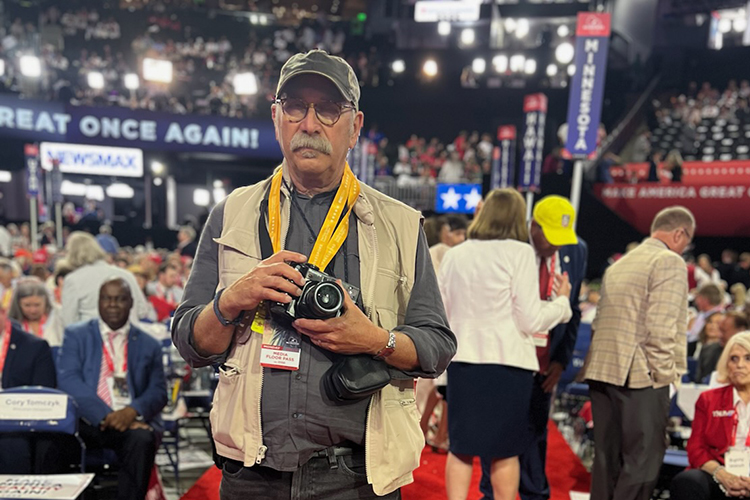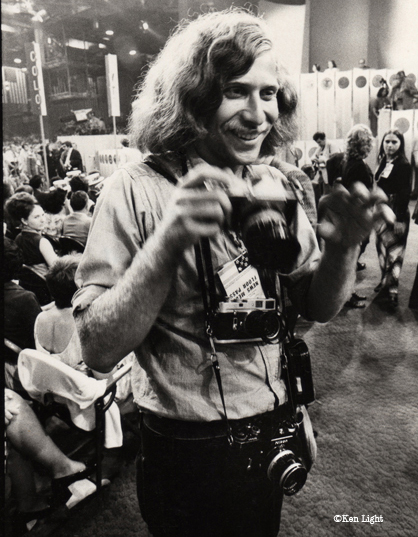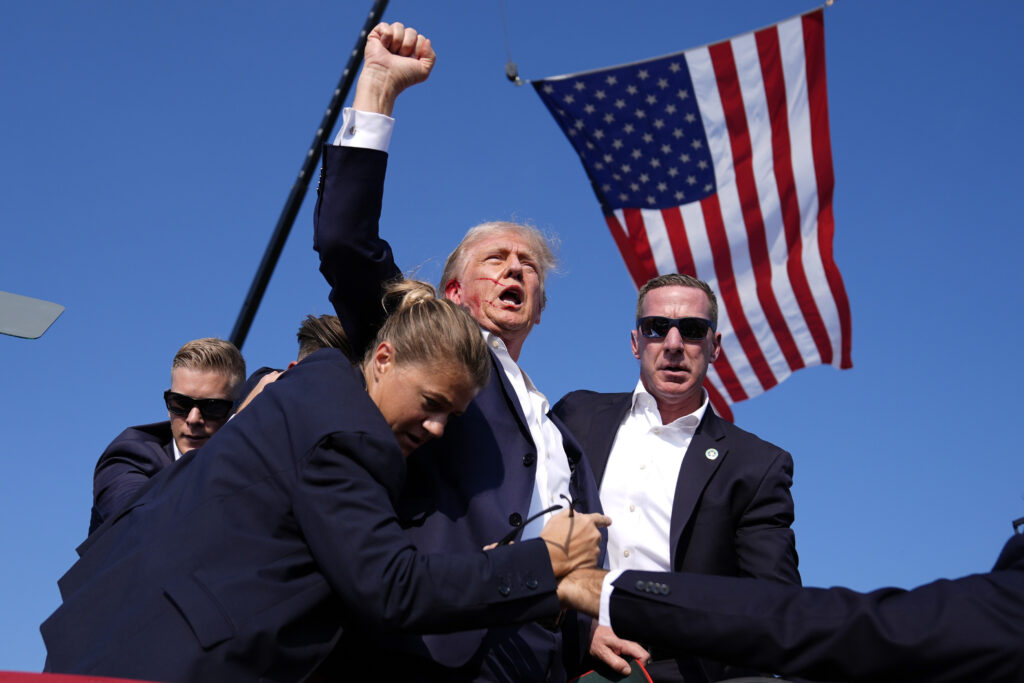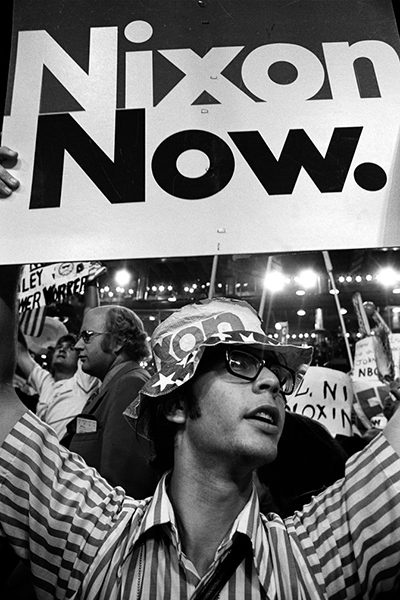Camera in hand, Berkeley professor chronicles this week’s Republican National Convention
Ken Light, a documentary photojournalist, and two of his former students are jockeying for the best shots.

July 17, 2024
Professor and documentary photojournalist Ken Light had just watched two movies on a flight from San Francisco to the Midwest on Saturday to photograph the Republican National Convention when he tuned into CNN.
“And there, of course, was the biggest story of the day,” he said of the attempted assassination that day of former President Donald Trump at a rally in Pennsylvania. “Of course it was a shock, and I began to wonder how this is going to change the political landscape.”
Light has focused his more than 50-year career — and 12 books — on social issues facing America, and he’s also photographed several national conventions. His first was the 1972 Republican National Convention in Miami, where Richard Nixon was nominated for a second term amid the Vietnam War and emerging Watergate scandal.

Photo courtesy of Ken Light
He also covered the 2016 Republican National Convention in Cleveland, where the party nominated Trump as its presidential candidate and Mike Pence as his running mate. Some of those photos are part of Light’s 10-year “Course of the Empire” project; a related show will open at Berkeley Journalism in September.
Light is on the floor of the four-day Milwaukee, Wisconsin, convention hall this week, as well as in the streets among protesters, with two of his former students, Jared Stapp and Wesaam Al-Badry. Stapp, like Light, is credentialed by Contact Press Images, and Al-Badry is shooting for Mother Jones.
Berkeley News checked in with Light about what he observed at the start of the convention, how the visuals differ from the 2016 convention, and what he’ll share with his photojournalism students this fall.
Berkeley News: Why did you decide to attend the convention?
Ken Light: My work and history as a photographer have been to take photographs of America for the last 50-something years, and I just felt this was a pivotal political moment in U.S. history. And because I got credentials, I just thought, “Go!” I work with a photography agency in New York and applied and went through Secret Service vetting. You have to wear your credential every day and then obtain a floor pass for each day at the convention.
I wondered what security would be like, and what the feeling of the delegates would be. Security hasn’t been that different from what I’ve seen at other conventions. But there are a lot of police everywhere, and they’ve even flown in officers from Fresno, over 150 of them, … and from states like Tennessee and Kentucky. There’s a big presence by uniformed officers.
Now, with so much tumult among Democrats, with Biden and so forth, I likely will also photograph the Democratic National Convention in August.

Evan Vucci/AP
What was the scene like on opening night in the city’s Fiserv Forum?
The big question on Monday was, “Is Donald Trump going to show up?” It’s unusual for a candidate to appear before the last day of the convention.
We heard he would arrive at 10 p.m. And then 9:30. On the floor of the convention center were still photographers, TV people, the pool video folks for the networks, and then Kaitlan Collins [from CNN] and her crew, CBS and its crew, the stand-up people you see on TV. We ended up in a spot waiting for an hour for Trump to come through the doorway, and behind us were zillions of people, the delegates who wanted to see this, to get a photo. There was a lot of pushing.
There were videographers with giant cameras on their shoulders. Their gear is huge, so they’re like wing Cadillacs.
In the crowd, people were talking about what they were going to shout — “U.S.A” or “Fight!” They ended up deciding to shout, “Fight!”
Finally, Trump came down the hallway, with a bandage on his ear.
So far, how do the visuals at the convention compare to 2016?
One of the things I really noticed was that, at the 2016 convention, there were a lot of American flags. People wore them, people held them. Here, I hardly see any of that. You have the occasional person wearing stars, or red, white and blue. There are a lot of Trump hats, but very few American flags.
I haven’t figured that part out. I don’t know if the cult of personality of Trump rises above the flag. There is a real cult of personality around him. These people love him, they just love him.
Among the most bizarre things I’ve seen here were a couple people with T-shirts that had the New York Times photo by Doug Mills of Trump with blood coming down his ear, his fist up and the American flag flying behind him. I also saw a woman wearing a big, giant antebellum dress with that photo spread on the bottom. It’s very strange, because Mills is here at the convention, photographing.
At one point, one of the backdrops on the stage, where the speakers are, was an image of a church. That was the American symbol.
What is it about that photo by Mills that captivates people so much?
The Doug Mills and the Associated Press photos are iconic images, and to many Trump supporters showed Trump’s ability to surmount even an assassination attempt and to tell his followers to fight on. It’s almost what you’d expect in a Hollywood movie, when the hero somehow overcomes every disaster that comes at him.

Ken Light/UC Berkeley
Are you seeing differences between protests at this week’s convention and the one in 1972, when war had divided the nation and Watergate was eroding public trust in government?
I’ve been thinking about that a lot. In ’72, the protests were much more dynamic and widespread. There was [an anti-Republican Party, anti-Trump] march here this week, but it was much smaller, nothing like ’72. In ’72, there also were a lot of arrests and tear gas, and I remember that tear gas got blown into the convention hall through the air ducts. Security also wasn’t as codified as it is now.
I’ve also seen differences between this convention and the 2016 Republican convention, when Trump was first nominated. There was a lot of silliness to photograph then — a guy dressed as Abraham Lincoln, people in weird hats and clothes. There’s a lot less of that now. If I think about that convention, eight years ago, in that short time the whole political landscape has changed. Politics are more entrenched, more serious. Democrats were upset about Trump during that time, but now, they’re talking about the end of democracy and about him being a dictator.
What do you teach your photojournalism students about covering the news?
Having photographed so much of America, I tell them that you can take in what’s in front of you and not think it’s important, but it’s all history we’re witnessing, and it’s your responsibility to tell stories. You need to be out in the world.
For example, we’ll probably do a session or two this fall about how to be in a demonstration, and work there safely, particularly if Trump wins, because riots happened last time he won, and journalists need to know how to operate in that environment.
People at protests used to be happy to be photographed, and now they’re often not. They fear the photos will be seen by others, like their employers, on social media. They want to curate their own lives. You’re stepping into their world, you don’t have a right to be there. I teach a semester-long law and ethics class, and I do a session about rights.
What’s your plan today, at the convention?
There are a couple public events going on outside, and then we’re back inside for more of the convention.
It’s been hot and humid, and a big storm rolled through on Monday night. But the convention center is very nicely air-conditioned, I might add.